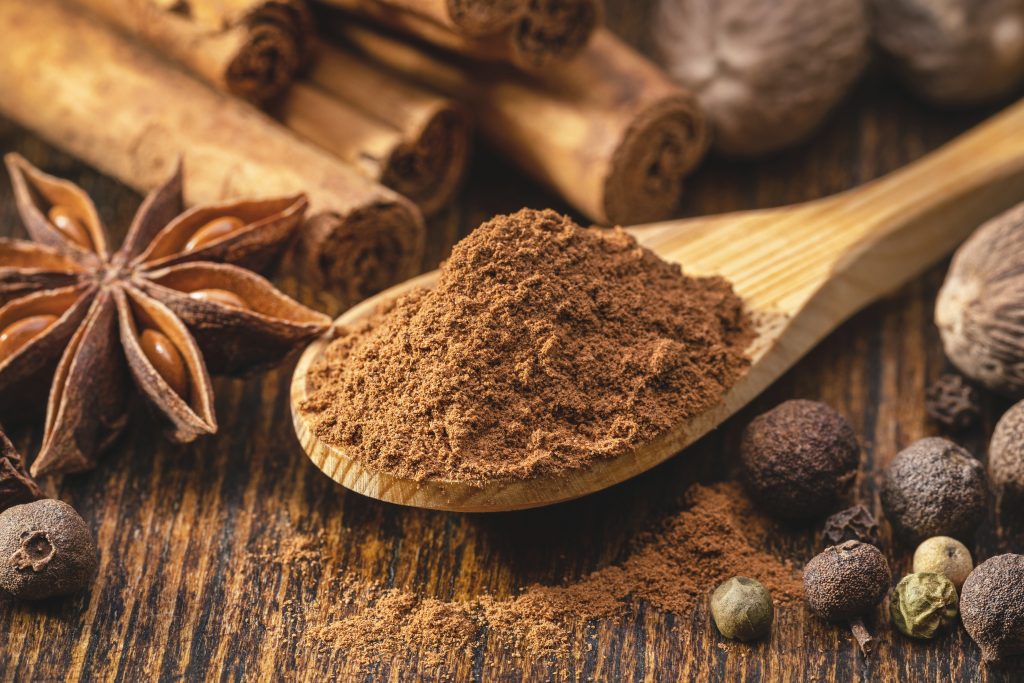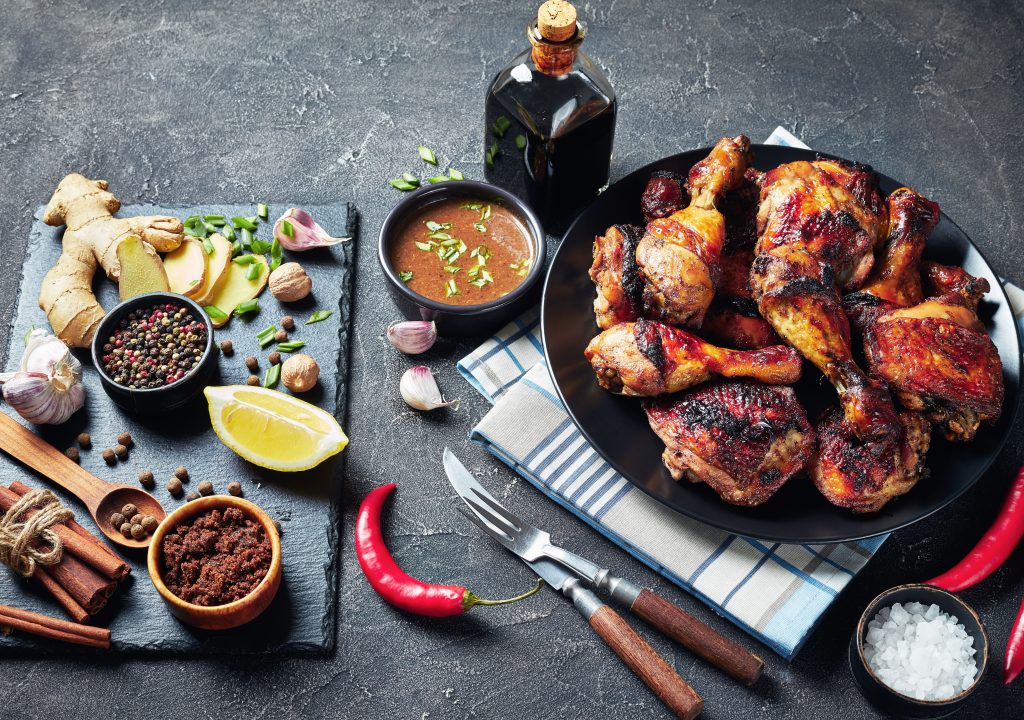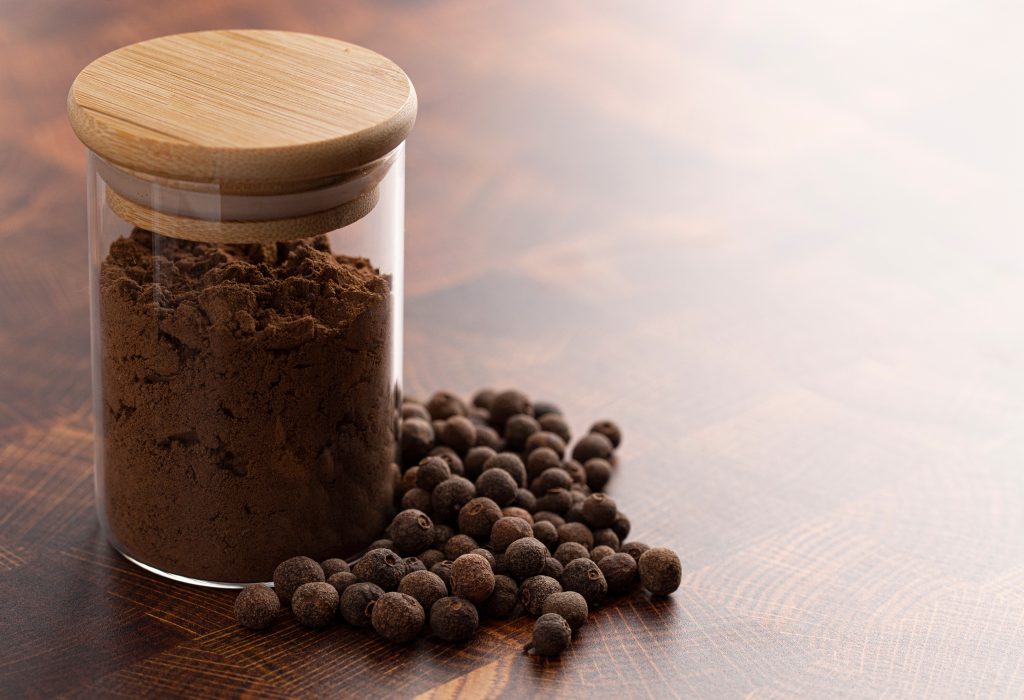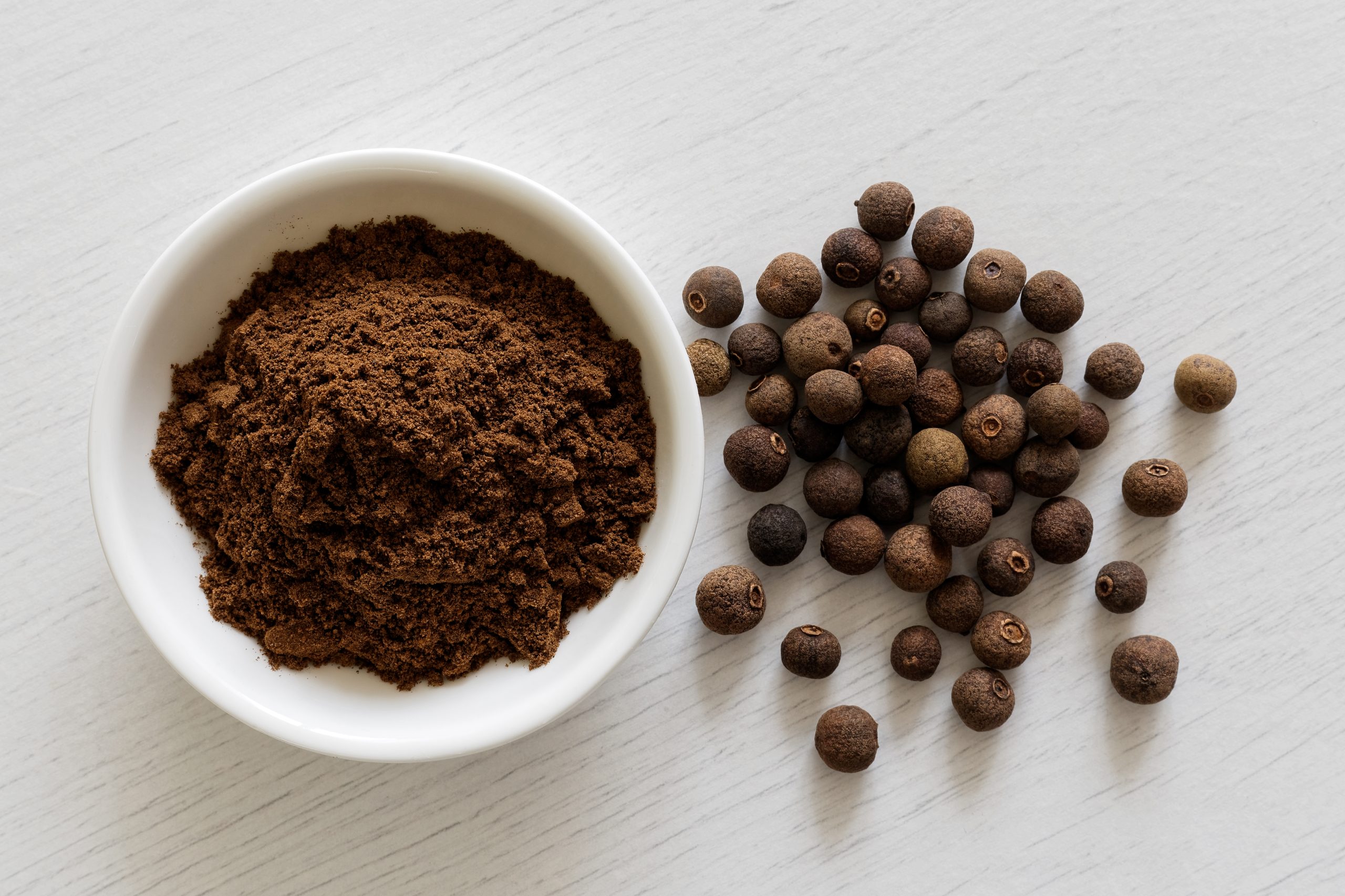Allspice is a unique berry of the Pimenta dioica plant native to South and Central America. The name of the fruit is derived from its exotic flavors of cinnamon, nutmeg, and cloves. It has been used for centuries in cooking and has various health benefits.
Table of Contents
What is Allspice?
Allspice is the dried, unripened berry of the allspice tree, which is native to the Caribbean, and Central and South America. It is also known as Jamaica pepper, myrtle pepper, pimenta, or pimento.
The name “allspice” comes from its flavor profile and aroma, combining the flavors of cinnamon, nutmeg, and cloves; hence, it was believed to be a mixture of all three spices.
However, the flavor of allspice is distinct and unique, with a warm and spicy aroma similar to cinnamon and cloves but with a slightly bitter and peppery taste.
Allspice berries are small and spherical, about 2 to 3 millimeters in diameter, and dark brown. The berries have a tough outer shell containing a single seed in the center. When dried, the berries release their essential oils, which give them their characteristic flavor and aroma.

Allspice is widely used in Caribbean, Mexican, and Middle Eastern cuisine, but is also popular in many European and American recipes, including desserts, pickling brines, marinades, and sauces. It is often used in pickling, baking, and making sausages and jerky.
In terms of appearance, allspice berries are similar in size and shape to black peppercorns, but they are slightly larger and darker in color. When ground, allspice is a fine powder that ranges in color from reddish-brown to dark brown, with an intense and spicy aroma.
The History of Allspice
Allspice has a fascinating history: The Mayans were known to use it for embalming and to add flavor to chocolate.
In 1494, European explorers brought Jamaican allspice berries to Europe, believing they had discovered a new type of pepper. As a result, the berry’s Latin name, pimenta, means “peppercorn.”
In 1621, the British named the berry “Allspice” due to its potent aroma. Interestingly, in the book “The Art of Distillation,” which influenced the creation of spirits, allspice was referred to as Bayberry. It was also given the Latin name Linnæus back in 1758 by Carolus Linnæus himself.
The highest grade of allspice is currently found in Jamaica.
What Does Allspice Taste Like?
When tasted raw, allspice has a warm and pungent aroma with hints of clove, cinnamon, and nutmeg. It has a slightly sweet and spicy flavor with notes of peppercorn and juniper.
When used in cooking, allspice adds a warm and fragrant flavor to various dishes and is particularly popular in dishes such as jerk chicken, meat stews, and baked goods. When cooked, allspice adds a complex, slightly sweet, and spicy flavor to dishes, similar to its raw taste but more subdued.
How to Tell When Allspice is Ripe
Here’s how to tell when allspice is ripe:
| Color | The ripe allspice fruit is dark blue-purple. |
| Size | Ripe allspice fruits are about the size of a pea or small marble. |
| Texture: | The skin of a ripe allspice fruit is smooth and glossy. |
| Aroma | When the fruit is ripe, it has a sweet and spicy fragrance. |
Note: When buying dried allspice, it’s essential to check that the berries are whole and not broken, as they can quickly lose flavor.
Can I Eat Raw Allspice?
Yes, but eating raw allspice is generally not recommended as it can be challenging to digest and may cause gastrointestinal issues. Allspice is usually used in its ground form or as whole dried berries in cooking and baking.
If you consume allspice in its raw form, it should be in small amounts and not regularly.
Cooking with Allspice
Despite its name, allspice is not a blend of different spices but a single spice with a unique flavor reminiscent of a mix of ground cinnamon, ground nutmeg, and ground cloves.
Allspice is typically used as a seasoning in both sweet and savory dishes. It is commonly used in marinades and rubs for meats and in stews, soups, curries, and spice blends like pumpkin pie spice. It’s also an ingredient used in Jamaican jerk seasoning.
In sweet dishes, it is used in baked goods, such as cakes, cookies, and pies (pumpkin or apple pies), and in fruit desserts, such as apple and pear crisps.
It is also used in Middle Eastern and North African cuisines, in spice blends such as baharat and sometimes ras el hanout. In addition, allspice can be seen in holiday dishes such as gingerbread and mulled wine.

Here are a few examples of specific dishes that use allspice:
Jamaican Jerk Chicken: This recipe is a classic, but it has a little spice that makes it stand out from the crowd. You can serve the tender chicken at the end as an entrée or a side dish.
Lebanese Kibbeh: Kibbeh is typically made with ground lamb, onion, and bulgur wheat. The mixture is then shaped into balls or patties and fried or baked. Adding allspice gives this dish an extra dimension of flavor, making it unique.
Swedish Meatballs: These Swedish meatballs are a classic Scandinavian dish made with ground meat and spices, including allspice, accompanied by some delicious gravy. The meatballs are typically served with lingonberry jam and mashed potatoes.
How to Store Allspice
To store allspice fruit, you can follow these steps:
- Choose ripe, fresh allspice berries that are dry and firm.
- Remove any damaged or bruised berries and discard them.
- Place the allspice berries in an airtight container, such as a glass jar with a tight-fitting lid.
- Store the container in a cool, dry, dark place like a pantry or cupboard.
- Ensure the container is away from direct sunlight, heat sources, and moisture.
- Check the container regularly for any signs of dampness or mold.
- Allspice berries can last for up to two years if stored properly.
Note: If you have ground allspice, it has a shorter shelf life than whole allspice berries. It can last up to six months if stored in an airtight container in a cool, dry, and dark place.

Nutritional Benefits of Allspice
Here are some ways that allspice berries can be beneficial:
Allspice contains compounds such as eugenol, ethyleugenol, and caryophyllene with anti-inflammatory and antimicrobial properties. Research also indicates that allspice’s eugenol and gallic acid have antiproliferative and anti-tumor properties.
Allspice essential oil can be used similarly to clove oil to alleviate pain and muscle soreness and reduce indigestion, cramps, and cold symptoms.
It is also an excellent alternative for sweetening baked goods and other recipes without adding calories and sugar. Allspice is also frequently used to create herbal teas and infusions that can alleviate digestive issues like gas, cramps, and menstrual pain.
Where to Purchase Allspice
Allspice is widely available in most grocery stores and supermarkets in the spice aisle. It can be purchased in both ground and whole form. It’s important to note that ground allspice loses its flavor quickly, so buying whole allspice and grinding it as needed is best.
Regarding availability, allspice is typically in season from August to October. However, it can be found year-round in most places due to this spice’s widespread use and popularity.
If you’re looking for high-quality allspice and are having trouble finding it in your local grocery store, consider checking out a specialty store or online spice retailers.

